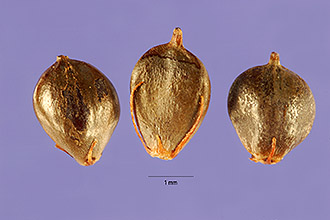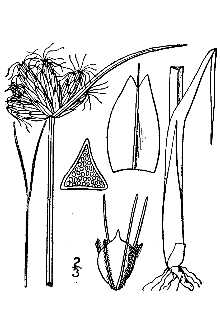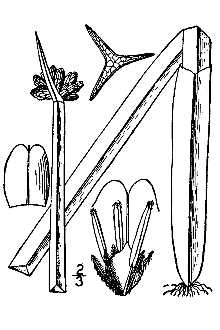Scirpus chilensis Nees & Meyen ex Kunth
Scientific Name: Scirpus chilensis Nees & Meyen ex Kunth

| General Information | |
|---|---|
| Usda Symbol | SCCH5 |
| Group | Monocot |
| Life Cycle | Perennial |
| Growth Habits | Graminoid |
| Native Locations | SCCH5 |
Plant Guide
Alternative Names
American bulrush, Olney’s three-square, three-cornered grass, three-cornered sedge, bayonet rush, three square sedge, American three square, Scirpus americanus
Uses
Ethnobotanic: American three square stems were used by the Nuu-chah-nulth as the foundation material for their beautiful wrapped-twine baskets of tall basket sedge (Pojar & Mackinnon 1994). The leaves were used in making shopping bags and woven into hats (Moerman 1998). The leaves mixed with oil was rubbed on childrens’ heads to make their hair grow long and thick (Ibid.). Schoenoplectus americanus seeds are rich in protein and can be ground and added to flour when making breads and cakes. The seed can be ground into a powder, mixed with water, boiled and eaten as a mush (Moerman 1998). Wildlife: American three square rhizomes are preferred by muskrat and snow goose. The seeds are eaten by over wintering ducks in the south as a small part of their diet. The achenes are eaten by waterfowl. This species provides cover for many birds and small mammals. R. Mohlenbrock USDA,NRCS,Wetlands Institute @ PLANTS
Status
Please consult the PLANTS Web site and your State Department of Natural Resources for this plant’s current status, such as, state noxious status and wetland indicator values.
Description
General: Sedge family (Cyperaceae). American three square is a medium height to tall, erect native herbaceous plant, up to seven feet tall (Tiner 1987). This species is a perennial from long stout rhizomes; with single stems that are in small groups, sharply triangular, fifteen to one hundred centimeters tall (Pojar & MacKinnon 1994). The leaves are firm, long, and strongly folded, sometimes flat and two to four millimeters wide. The fruits are dark-brown, seedlike, pointy tipped achenes, two to three millimeters long (Ibid.). Distribution: For current distribution, please consult the Plant profile page for this species on the PLANTS Web site.
Adaptation
American three square occurs along streams, around ponds and lakes, in sloughs, swamps, fresh and brackish marshes, wet woods, and roadside ditches; common at low elevations. It also occurs in beach pools and sandy flats, often in shallow water up to about one foot or even 2.5 feet (Voss 1972).
Establishment
Propagation by Seed: Sow seeds in a cold frame pot standing in three centimeters of water. The seeds germinate quickly. When they are large enough to handle, plant them into their permanent positions in early summer. Large divisions can be planted directly into their permanent positions. It is best to pot smaller divisions and grow them in a cold frame, out-planting after they are well established in the summer.
Management
Maintenance of American three square stands depends primarily on water levels and salinity levels. Maximum survival and growth in coastal areas occur where average minimum yearly water levels do not fall below five to four inches above the soil surface. Cultivars, Improved and Selected Materials (and area of origin) Available through wetland plant nurseries. Contact your local Natural Resources Conservation Service (formerly Soil Conservation Service) office for more information. Look in the phone book under ”United States Government.” The Natural Resources Conservation Service will be listed under the subheading “Department of Agriculture.”
References
Braun, L,E, 1967, The monocotyledoneae from cat-tails to orchids, The Ohio State University Press, Columbus, Ohio, Bruggen, T, V, 1976, The vascular plants of South Dakota, The Iowa State University Press, Ames, Iowa, Gleason, H, A, 1952, The new Britton and Brown illustrated flora of the northeastern United States and adjacent Canada, 3 vols, The New York Botanical Garden, New York, New York, Moerman, D, 1998, Native American ethnobotany, Timber Press, Oregon, Mohlenbrock, R,H,, ed, 1975, Guide to the vascular flora of Illinois, Southern Illinois University Press, Carbondale, Illinois, Munz, P, Use soil moisture sensors to measure the soil moisture of Scirpus chilensis Nees & Meyen ex Kunth.,A, 1965, A California flora, University of California Press, Berkeley & Los Angeles, California, Pojar, J, & A, MacKinnon 1994, Plants of the Pacific Northwest coast: Washington, Oregon, British Columbia, and Alaska, Lone Pine Publishing, Redmond, Washington, Steyermark, J, A, 1963, Flora of Missouri, The Iowa State University Press, Ames Iowa, Strausbaugh, P, D, & E, L, Core 1977, Flora of West Virginia, 2nd ed, Seneca Books, Inc,, Morgantown, West Virginia, Swink, F, & G, S, Wilhelm 1979, Plants of the Chicago region, 3rd ed, The Morton Arboretum, Lisle, Illinois, The Great Plains Flora Association 1986, Flora of the Great Plains, University Press of Kansas, Lawrence, Kansas, Tiner, R,W, Jr, 1987, A field guide to coastal wetland plants of the northeastern United States, The University of Massachusetts Press, Amherst, Massachusetts, Voss, E,G, 1972, Michigan flora, Cranbrok Institute of Science, Bloomfield Hills, Michigan, & University of Michigan Herbarium,


